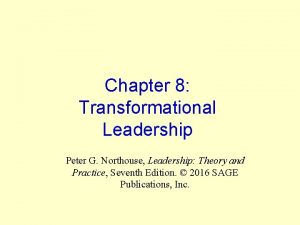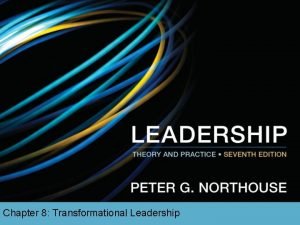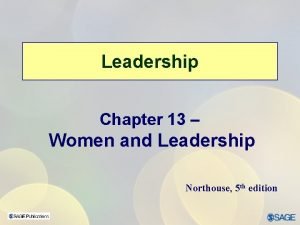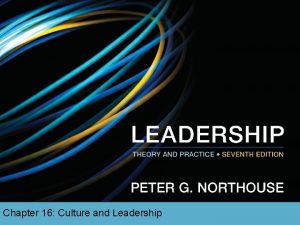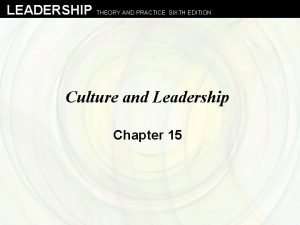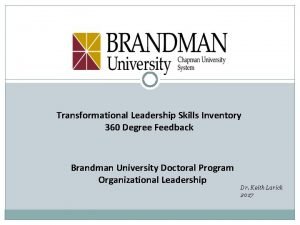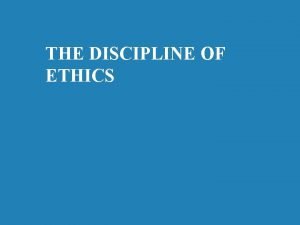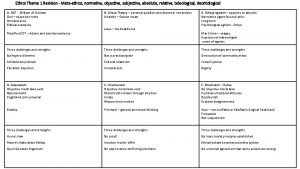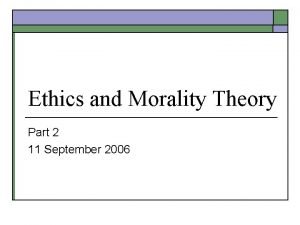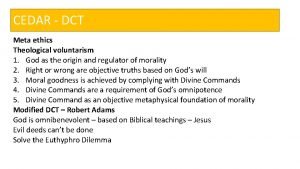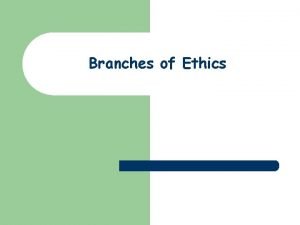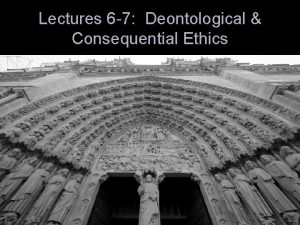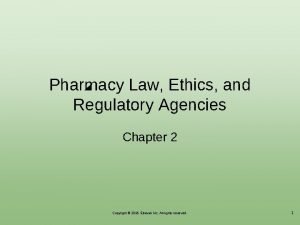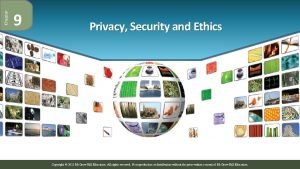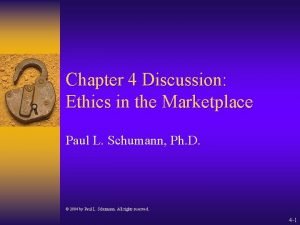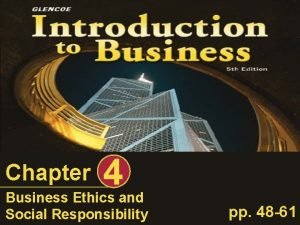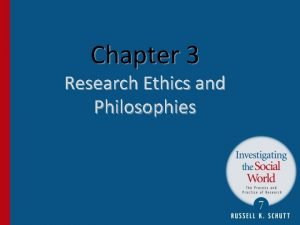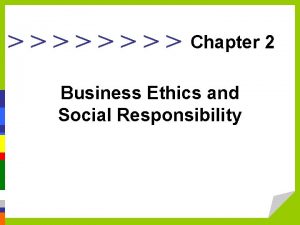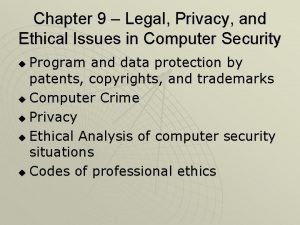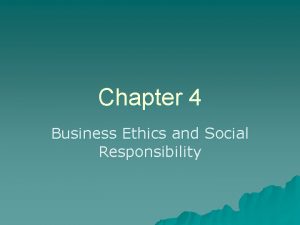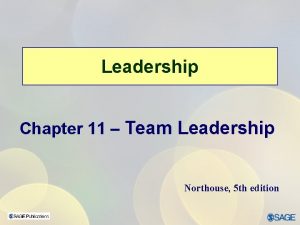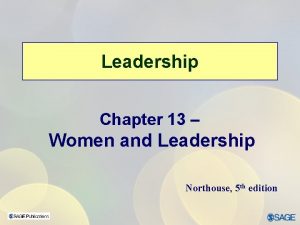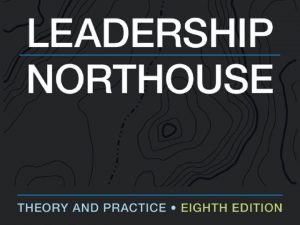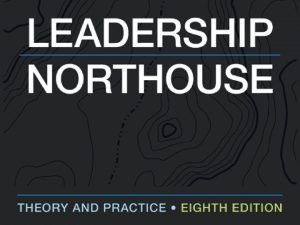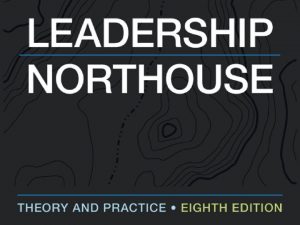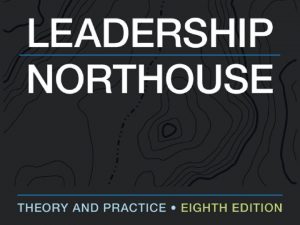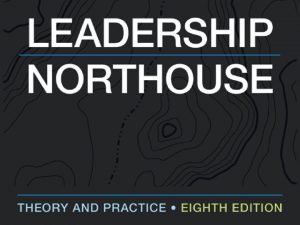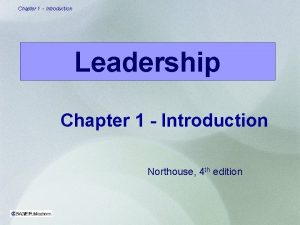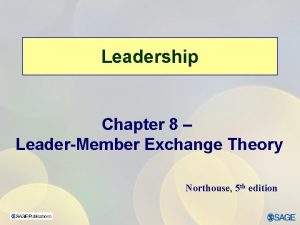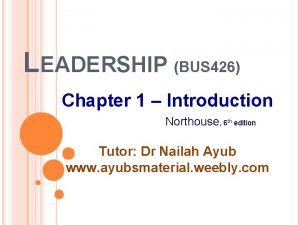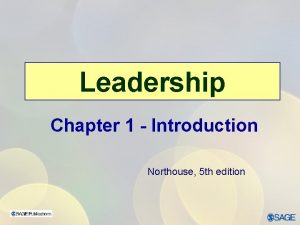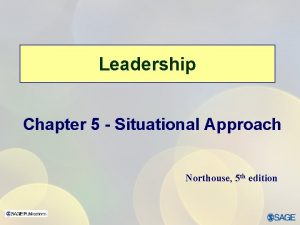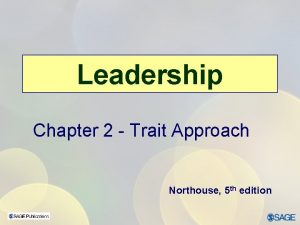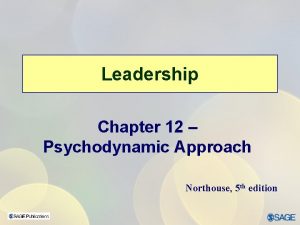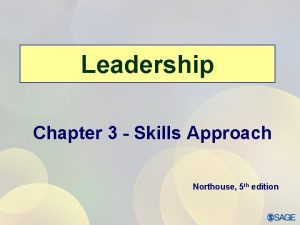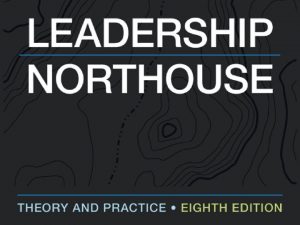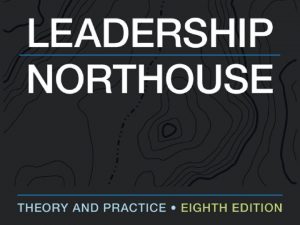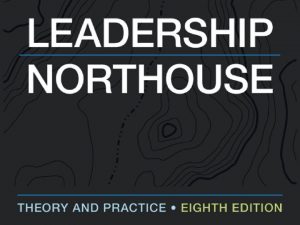Leadership Ethics Chapter 13 Northouse Leadership 8 e
































- Slides: 32


Leadership Ethics Chapter 13 Northouse, Leadership 8 e. © SAGE Publications, 2019. 2

Overview Leadership Ethics Perspective Practical Ethical Theory Ethical Theories Principles of Ethical Leadership Diverse Ethical Perspectives How Does the Leadership Ethical Perspective Work? Northouse, Leadership 8 e. © SAGE Publications, 2019. 3

Leadership Ethics Description Definition and Theory Ethics · Is a derivative of the Greek word ethos, meaning customs, conduct, or character · Is concerned with the kinds of values and morals an individual or society ascribes as desirable or appropriate · Focuses on the virtuousness of individuals and their motives · Example: Journalists’ respect for others, professional duty, concern for harm, proactive social engagement (Plaisance, 2017) Northouse, Leadership 8 e. © SAGE Publications, 2019. 4

Practical Ethical Theory Kohlberg’s Stages of Moral Development Level 1. Pre-conventional morality Stage 1 --Obedience and Punishment: Rules are fixed and handed down by authority Stage 2 --Individualism and Exchange: An action is right if it serves the individual Level 2. Conventional morality Stage 3 --Interpersonal Accord and Conformity: Conforming to the expectations of others Northouse, Leadership 8 e. © SAGE Publications, 2019. 5

Kohlberg’s Stages of Moral Development Stage 4 --Maintaining the Social Order: Moral decisions show concern for society as a whole Level 3. Post-conventional Morality Stage 5 --Social Contract and Individual Rights: Moral decisions based on what a good society should be like Stage 6 --Universal Principles: Moral decisions based on internalized universal principles of justice that apply to everyone Northouse, Leadership 8 e. © SAGE Publications, 2019. 6

Ethics Defined Northouse, Leadership 8 e. © SAGE Publications, 2019. 7

Leadership Ethics Description Definition and Theory Ethical Theory · Provides a system of rules or principles as a guide in making decisions about what is right/wrong and good/bad in a specific situation · Provides a basis for understanding what it means to be a morally decent human being Northouse, Leadership 8 e. © SAGE Publications, 2019. 8

Ethical Theories Two Broad Domains: Theories about leaders’ conduct and about leaders’ character Northouse, Leadership 8 e. © SAGE Publications, 2019. 9

Ethical Theories Northouse, Leadership 8 e. © SAGE Publications, 2019. 10

Ethical Theories Teleological Theories: focus on consequences of actions and results Conduct Ethical egoism (create greatest good for the leader) Closely related to transactional leadership theories Example: leader takes a political stand on an issue for no other reason than to get re-elected Utilitarianism (create greatest good for greatest number) Example: Leader distributes scarce resources so as to maximize benefit to everyone, while hurting the fewest; preventive health care vs. catastrophic illnesses Altruism (show concern for best interests of others) Authentic transformational leadership is based on altruistic principles Example: The work of Mother Teresa, who gave her entire life to help the poor Northouse, Leadership 8 e. © SAGE Publications, 2019. 11

Ethical Theories Conduct Deontological Theories ·Duty driven, for example, relates not only to consequences but also to whether action itself is good ·Focus on the actions of the leader and his/her moral obligation and responsibilities to do the right thing ·Example: telling the truth, keeping promises, being fair Northouse, Leadership 8 e. © SAGE Publications, 2019. 12

Ethical Theories Character Virtue-based Theories: About leader’s character · Focus on who people are as people • Rather than tell people what to do, tell people what to be • Help people become more virtuous through training and development • Virtues are present within person’s disposition; practice makes good values habitual § Examples: Courage, honesty, fairness, justice, integrity, humility Northouse, Leadership 8 e. © SAGE Publications, 2019. 13

Centrality of Ethics to Leadership Influence dimension of leadership requires the leader to have an impact on the lives of followers Power and control differences create enormous ethical responsibility for leaders Respect for persons--sensitive to followers’ own interests and needs Leaders help to establish and reinforce organizational values--an ethical climate Northouse, Leadership 8 e. © SAGE Publications, 2019. 14

Diverse Perspectives of Leadership Heifetz’s Perspective Emphasizes how leaders help followers to confront conflicting values and to effect change from conflict · Ethical perspective that speaks directly to • Values of workers • Values of organizations and the communities in which they work Northouse, Leadership 8 e. © SAGE Publications, 2019. 15

Diverse Perspectives of Leadership Heifetz’s Perspective Leaders use authority to mobilize followers to Get people focused on issues Act as a reality test regarding information Manage and frame issues Orchestrate conflicting perspectives Facilitate the decision-making process Northouse, Leadership 8 e. © SAGE Publications, 2019. 16

Diverse Perspectives of Leadership Heifetz’s Perspective Leaders use authority to mobilize followers to Get people focused on issues Act as a reality test regarding information Manage and frame issues Orchestrate conflicting perspectives Facilitate the decision-making process Leader provides a holding environment, a supportive context in which there is Trust, nurturance, & empathy Leader’s duties Assist the follower in struggling with change and personal growth Northouse, Leadership 8 e. © SAGE Publications, 2019. 17

Diverse Perspectives of Leadership Burns’s Perspective Theory of Transformational Leadership · Strong emphasis on followers’ needs, values, and morals · Leaders help followers in their personal struggles concerning conflicting values · Stressing values such as liberty, justice, and equality · Connection between leader and follower • Raises level of morality of both Leader’s Role · Assist followers in assessing their values & needs · Help followers to rise to a higher level of functioning Northouse, Leadership 8 e. © SAGE Publications, 2019. 18

The Dark Side of Leadership Pseudotransformational leadership Characterized by destructive behaviors, such as violating basic human rights (Lipman-Blumen, 2005) Characterized by personal characteristics, such as lack of integrity, insatiable ambition, arrogance (Lipman-Blumen) Eight factors of perceived toxicity in leaders: managerial incompetency, dark traits, derisive supervision, impervious despotic leadership, dearth of ethics, erratic behavior, narcissism, and self-promoting (Singh et al. , 2017) Associated with workplace outcomes such as negative attitudes in followers toward jobs and organization as a whole (Schyns and Schilling, 2013) Northouse, Leadership 8 e. © SAGE Publications, 2019. 19

The Dark Side of Leadership Northouse, Leadership 8 e. © SAGE Publications, 2019. 20

The Toxic Triangle Destructive Leaders · Charismatic, narcissistic, self-absorbed Susceptible Followers · Conformers and colluders Conducive Environments · Unstable environments may grant leader more authority Northouse, Leadership 8 e. © SAGE Publications, 2019. 21

Ethical Leaders Respect Others Ethics--is central to leadership because of The process of influence The need to engage followers to accomplish mutual goals The impact leaders have on establishing the organization’s values Northouse, Leadership 8 e. © SAGE Publications, 2019. 22

Principles of Ethical Leadership Treating others as ends (their own goals) rather than as means (to leaders’ personal goals) Respects Others Leader shall: Treat other people’s values and decisions with respect Leader behaviors: Listens closely to subordinates Is empathic Is tolerant of opposing viewpoints Northouse, Leadership 8 e. © SAGE Publications, 2019. Allow others to be themselves with creative wants and desires Approach others with a sense of unconditional worth and value individual differences 23

Principles of Ethical Leadership Follower centered--Based on the altruistic principle of placing followers foremost in the leader’s plans Leaders have Serves Others Leader behaviors Mentoring behaviors Empowerment behaviors Team-building behaviors Citizenship behaviors Northouse, Leadership 8 e. © SAGE Publications, 2019. A duty to help others pursue their own legitimate interests and goals To be stewards of the organization’s vision; in serving others they: clarify, nurture, and integrate the vision with, not for, organization members An ethical responsibility to make decisions that are beneficial to their followers’ welfare 24

Principles of Ethical Leadership Ethical leaders are concerned with issues of fairness and justice; they place issues of fairness at the center of their decision making Leaders shall: Shows Justice Adhere to principles of distributive justice Leader behaviors All subordinates are treated in an equal manner In special treatment/special consideration situations, grounds for differential treatment are clear, reasonable, and based on sound moral values Northouse, Leadership 8 e. © SAGE Publications, 2019. 25

Principles of Ethical Leadership Northouse, Leadership 8 e. © SAGE Publications, 2019. 26

Principles of Ethical Leadership Honest leaders are authentic but also sensitive to the feelings and attitudes of others Manifests Honesty Leaders: Are not deceptive Tell the truth with a balance of openness and candor while monitoring what is appropriate to disclose in a particular situation Northouse, Leadership 8 e. © SAGE Publications, 2019. Leader behaviors Don’t promise what you can’t deliver Don’t suppress obligations Don’t evade accountability Don’t accept “survival of the fittest” pressures Acknowledge and reward honest behavior in the organization 27

Principles of Ethical Leadership Concern for common good means leaders cannot impose their will on others; they search for goals that are compatible with everyone. Builds Community Ethical leaders & Leader behaviors Takes into account purposes of everyone in the group Is attentive to interests of the community and culture Does not force others or ignore intentions of others Northouse, Leadership 8 e. © SAGE Publications, 2019. followers take into account purposes of everyone in the group, and reach out beyond their own mutually defined goals to wider community 28

How Does the Ethical Leadership Perspective Work? Strengths Criticisms Application Northouse, Leadership 8 e. © SAGE Publications, 2019. 29

Strengths Provides a body of timely research on ethical issues Provides direction on how to think about ethical leadership and how to practice it Suggests that leadership is not an amoral phenomenon and that ethics should be considered as integral to the broader domain of leadership Highlights principles and virtues that are important in ethical leadership development Northouse, Leadership 8 e. © SAGE Publications, 2019. 30

Criticisms Lacks a strong body of traditional research findings to substantiate theoretical foundations. Conceptual confusion regarding the concept; hard to measure (Exception is Yukl et al. , 2013) Relies heavily on writings of just a few individuals that are primarily descriptive and anecdotal in nature and are strongly influenced by personal opinion and a particular worldview. Most research based on Western world and Anglo-American countries Generational differences in ethical perspectives Northouse, Leadership 8 e. © SAGE Publications, 2019. 31

Application Can be applied to individuals at all levels of organization and in all walks of life. Because leadership has a moral dimension, being a leader demands awareness on our part of the way our ethics define our leadership. Managers and leaders can use information on ethics to understand themselves and strengthen their own leadership. Leaders can use ethical principles as benchmarks for their own behavior. Leaders can learn that leader-follower relationship is central to ethical leadership. Northouse, Leadership 8 e. © SAGE Publications, 2019. 32
 Servant theory
Servant theory Northouse chapter 8
Northouse chapter 8 Transformational leadership northouse chapter 8
Transformational leadership northouse chapter 8 Leadership labyrinth northouse
Leadership labyrinth northouse Culture and leadership northouse
Culture and leadership northouse Servant leadership northouse
Servant leadership northouse Culture and leadership northouse
Culture and leadership northouse Transformational leadership inventory
Transformational leadership inventory Leadership labyrinth northouse
Leadership labyrinth northouse Peter northouse
Peter northouse Descriptive ethics
Descriptive ethics Normative ethical questions
Normative ethical questions Macroethics definition
Macroethics definition Descriptive ethics vs normative ethics
Descriptive ethics vs normative ethics Meta ethics vs normative ethics
Meta ethics vs normative ethics Descriptive ethics vs normative ethics
Descriptive ethics vs normative ethics Compensatory justice examples
Compensatory justice examples Is/ought distinction
Is/ought distinction Main branches of ethics
Main branches of ethics Deontological ethics definition
Deontological ethics definition Teleological ethics vs deontological ethics
Teleological ethics vs deontological ethics Transactional leadership vs transformational leadership
Transactional leadership vs transformational leadership What is adaptive leadership theory
What is adaptive leadership theory Enthusiastic beginner disillusioned learner
Enthusiastic beginner disillusioned learner Pharmacy law ethics and regulatory agencies
Pharmacy law ethics and regulatory agencies Chapter 9 privacy security and ethics
Chapter 9 privacy security and ethics Ethics in the marketplace chapter 4
Ethics in the marketplace chapter 4 Business ethics chapter 4
Business ethics chapter 4 Chapter 3 research ethics
Chapter 3 research ethics Chapter 2 business ethics and social responsibility
Chapter 2 business ethics and social responsibility Chapter 9: ethics of documentation and authentication
Chapter 9: ethics of documentation and authentication Business ethics chapter 4
Business ethics chapter 4 Social responsibility and ethics in strategic management
Social responsibility and ethics in strategic management

